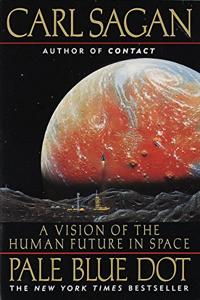
Want to learn the ideas in Pale Blue Dot better than ever? Read the world’s #1 book summary of Pale Blue Dot by Carl Sagan here.
Read a brief 1-Page Summary or watch video summaries curated by our expert team. Note: this book guide is not affiliated with or endorsed by the publisher or author, and we always encourage you to purchase and read the full book.
Video Summaries of Pale Blue Dot
We’ve scoured the Internet for the very best videos on Pale Blue Dot, from high-quality videos summaries to interviews or commentary by Carl Sagan.
1-Page Summary of Pale Blue Dot
Overview
Pale Blue Dot may seem like a book about space, but it’s really about the future of the human race. The book is written by Carl Sagan and is a vision of what will happen to us in space. It discusses how we’ll get there and even where we’re going once we do.
The first four chapters of Saganic theology deal with the idea that humans are self-centered and think their conflicts are important. They see themselves as strong, noble beings but in reality they’re weak and petty. It seems to be a common theme in Western religions that man is fallen, although the stars hold promise for human unity and redemption.
When we look at Earth from a distance, it looks like a pale blue dot. This perspective Sagan believes should make us realize how insignificant and small we are in the grand scheme of things. As science progresses, man is demoted further and further down on the scale of importance.
In the beginning, people believed that they were at the center of the universe. However, astronomy and biology proved them wrong by showing that man was not special in any way. Sagan argues that our position in the universe appears without any providential element.
Pale Blue Dot has twenty-two chapters. Chapters five through eighteen cover a variety of important material about science, the structure of the universe, and how to explore other worlds. Sagan discusses how to protect our planet and worries openly about various threats of apocalypse. In the last four chapters, Sagan argues passionately that our future lies in space and that it will help us get along with each other in a universe that is indifferent to us.
In the end, Sagan proposes a new religion that will emphasize humanity’s centrality in the universe. It will be based on science and reason rather than faith or mysticism. With this religion we can go to the sky as Chapter 21 suggests. In Chapter 22 he foreshadows humanity’s future across the stars and speculates about how we can recover a sense of purpose without God.
Section 0 Summary (Introduction, Wanderers)
Carl Sagan begins Pale Blue Dot by stating that humans have been wanderers since the beginning of their existence. Cavemen wandered to find fruit and meant, but when times were good they would settle down. However, men never forgot about wandering, as we can see in our stories and symbols. As civilization developed religion did as well; people saw themselves as mixed with it and began exploring the world with ships.
Our ancestors noticed that the stars moved in a way different from other stars. They were able to identify planets and today we know of many worlds beyond this one. The U.S. and Russia have studied these distant worlds, including Mercury and Saturn, for decades now with spacecrafts like Viking missions in 1976 which Carl Sagan was involved with.
We cannot travel to other planets, unlike our ancestors who traveled to the new world. This book is about those other worlds and what awaits us on them. Sagan will ask not only how we can go there but whether we should. Should we solve our problems at home first? Or are the planets themselves a reason for going? Sagan is optimistic about humanity’s prospects in space exploration and colonization of distant worlds. He believes that space exploration will be an important part of humanity’s future in the cosmos.





